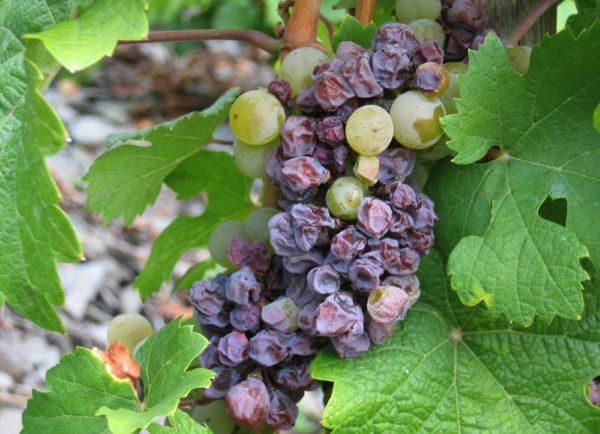Although grapes are unpretentious, in spite of this, it requires a certain amount of care. One of these activities is the prevention and treatment of diseases. Bringing new grape varieties, the breeders are working on this problem, but large-fruited varieties with high sugar content are still susceptible to various kinds of diseases. In order to get a high yield every year, a grower needs to be aware of the danger and be able to deal with it properly and know what to do.
Table of contents
Main types of grape diseases
The most common and common diseases of this culture are:
- mildew;
- Alternaria;
- chalcosporosis;
- arillariasis;
- oidium;
- aspergillus rot;
- chlorosis;
- rubella leaves;
- septoriosis;
- escoriosis
Mildew and his treatment
The second and more common name of the disease - downy mildew. This disease is very dangerous not only for the grape bush, it is capable of hitting the entire grape plantation in a short time. At the initial stage, it manifests itself in the form of light spots of yellow-oil color, the value of a kopek coin on young foliage. On older leaves, the spots have an angular shape and are parallel to the vein.
With further development on the back of the leaf appears mycelium in the form of a white fluffy bloom. If the weather is warm with high humidity, the fungal infection rapidly spreads to the tops of young shoots, whiskers, inflorescences and newly formed fruits strike.
The spores of the fungus are activated at a temperature of +10 degrees. The most favorable conditions for instantaneous distribution is an increase in air temperature from +20 to +27 degrees and humidity for 3 to 5 hours. However, at a temperature of +8 and above + 30 degrees, the fungal infection does not spread, since the spores do not germinate.
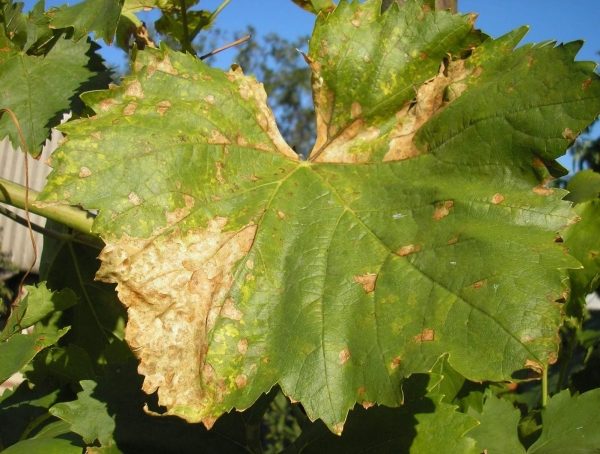
The most dangerous periods for the spread of infection are:
- May 20 — June 13;
- June 23–30;
- July 15 — August 7.
In order to avoid infection it is necessary:
- the right choice of a site for growing grapes;
- autumn mulching between rows;
- the correct formation of the vine to ensure good breathability;
- timely pruning of excess shoots;
- removal of weeds under bushes and between rows;
- drainage or drip irrigation;
- top dressing by mineral fertilizers;
- since the spring period, preventive treatment with bordeaux liquid every 10 days.
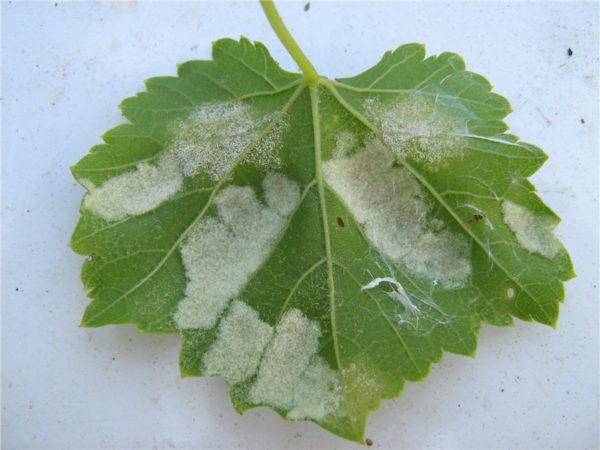
Alternaria disease
Alternaria, or olive blotch affects the leaves of the vine as a result of high humidity. Manifested in the form of spots on the back and olive-gray bloom. With the active development of the fungus, the leaves dry out and curl.
This type of fungal disease also affects the fruit. When storing them, the fungal infection spreads to healthy hands, affecting them. On fruits, the fungus manifests itself in the form of cracking and changes in the taste of berries. The processes affected by fungal infection do not ripen and do not tolerate wintering. Spores of the fungus overwinter on infected shoots, fruits and in the upper layers of the soil.
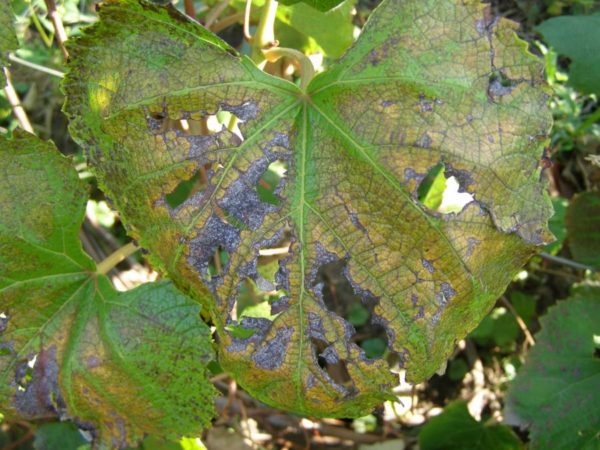
Necessary preventive measures are:
- timely pruning of infected processes;
- removal and burning of weeds and dry leaves;
- introduction of top dressing;
- treatment with copper sulphate and Bordeaux mixture.
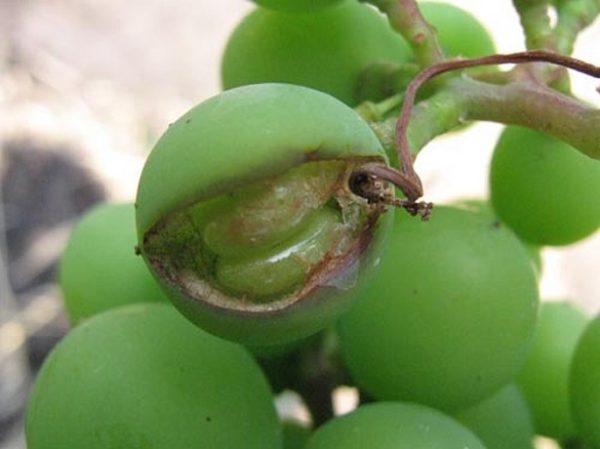
Terms of preventive measures:
- During the period from March 21 to April 12 after tying up the vines spray with copper-containing drugs.
- From April 24 to May 9 to process biofungicide.You can use for this purpose the drug "Trihofit".
- From May 16 to June 1 process drug "Kvadris." Continue processing every 14 days until the initial stage of ripening berries.
- From August 15 to September, after harvesting, prune the vine and burn it.
- From October 20 to November 10 it is necessary to scoop up the fallen leaves and treat the soil and the vine with copper-containing preparations.
Cercosporosis and how to deal with it
This fungal disease affects leaves, processes, peduncles and fruits. First of all, the foliage located close to the ground is affected, as the sun's rays penetrate poorly into this part of the bush, and there is increased humidity under the bushes. The most rapid development of this disease occurs at an air temperature of +30 degrees. If the temperature rises to + 40 degrees, the fungus stops growing. In direct sunlight, the fungus dies.
Manifested in the form of olive plaque on the bottom of the leaves. Over time, brown spots appear on the surface of the leaf, with a light touch, the leaves fall.
Affected berries are covered with an easily washable olive bloom, become hardened and fall off when touched.
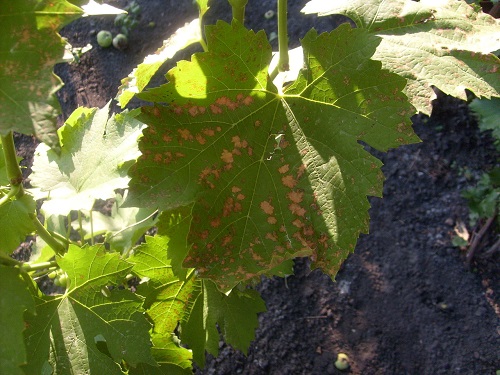
Preventive measures necessary to prevent the disease:
- obligatory pruning of grapes twice per season;
- deep digging of aisle in the spring and autumn periods;
- watering 4 times per season;
- weed removal;
- spraying the bushes in the fall and spring with a 1% solution of Bordeaux mixture;
- mandatory feeding.
When the disease is recommended:
- spray every two weeks with fungicides infected bushes;
- burn infected foliage.
Armillary disease affecting the roots
This disease is a fungal infection that develops on the roots of a plant. Infection infects the roots of grapes, penetrating into the cortex and releasing toxic substances, kills living tissue, and then develops on infected cells. Distributed by mushroom spores. Spores are extremely toxic, they can kill an infected plant. As a rule, infection occurs in the spring, and in the fall on the bush grow yellow mushrooms.
For the development of this disease should be high humidity and air temperature from +15 to 26 degrees. To prevent the spread of the disease, it is necessary to uproot the infected shrub, the soil should be treated with special fungicides and not planted new seedlings at this place during the year.
In order to prevent infection of the vineyard by arilliosis, bushes that grow along the forest belt must be separated using a ditch.
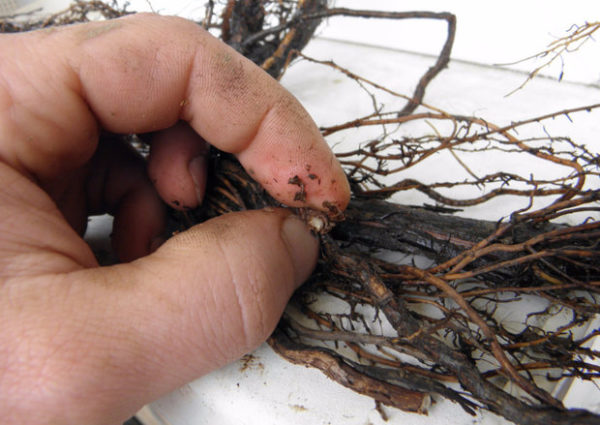
Aspergillus rot
With this disease affects the fruits of the grapes. A distinctive feature of this disease is its rapid development at high air temperature - above +31 degrees.

At first a little noticeable white bloom appears on the berries, then dark dented spots.Peel in these places is cracked and cracked. The pulp of the berry is rotting due to the presence of the drosophila fly larvae. On the surface of the cracks, the plaque initially has a white color, then darkens and turns into a dark powder mass.
Measures to combat this disease are:
- destruction of residues from fungal spores;
- timely harvesting.
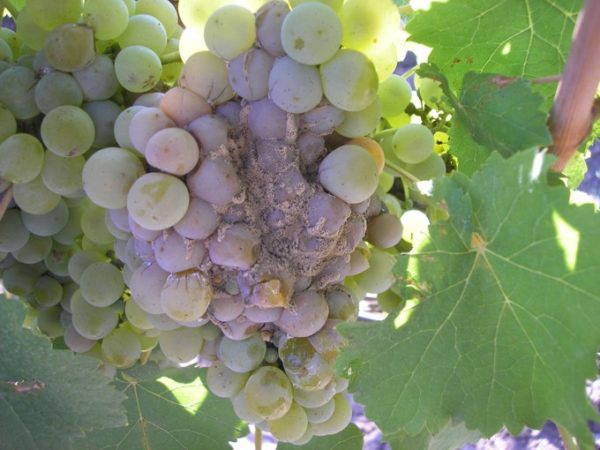
Oidium or powdery mildew
Fungal disease has a second name - powdery mildew. It affects the green mass of the bush, inflorescence shoots. With the defeat of the inflorescence does not develop or mature. This disease lives and progresses only on living cells. Overwintering in the cracks of the bark and on the kidneys.
Spores, falling on the leaves, multiply rapidly, carried by the wind. Exceptional conditions are high humidity (over 80%). Depending on the temperature, the incubation period lasts from a week to two weeks. Favorable temperature for the rapid development of the disease is the temperature of +20 degrees.
Signs of infection:
- white bloom on both sides of the sheet;
- the edge of the leaves is curved, yellow;
- the plaque appearing on the clusters and flowers resembles flour;
- shoots covered with dark spots;
- dead spots appear on the processes.
Prevention measures are as follows:
- digging the ground, cleaning the foliage and weeds;
- top dressing phosphorus-potassium fertilizers;
- treatment with Topaz;
- timely trimming of bushes in order to prevent the thickening of the vineyard;
- tool processing after trimming;
- Neat watering without hitting the bushes;
A solution of sulfur prepared in the following proportion is recommended for the treatment of a disease:
- water — 10 liters;
- sulfur — 100 grams.
This solution must be treated bushes in the evening.
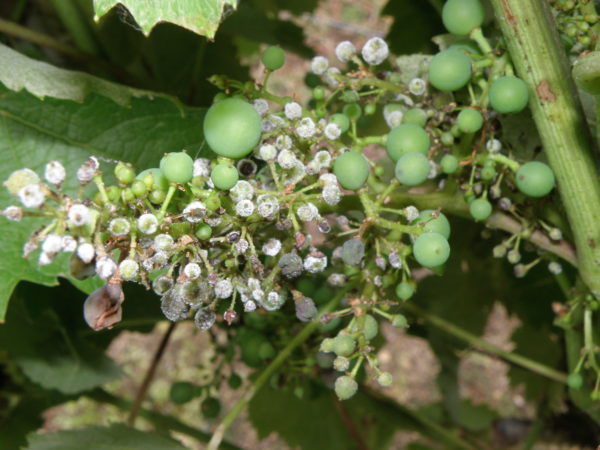
Chlorosis and control measures
Chlorosis disease occurs with a lack of iron. The plant does not produce photosynthesis, with the result that the development of the bush stops and the yield is reduced. Manifested in the form of spots on sheets of bright lemon color. Shoots stop development, and the sheets dry out and fall off. Fruits become small and do not reach maturity. A loose bush may not tolerate wintering.
Prevention of this disease is the treatment of the bushes with the “Chelate” preparation.
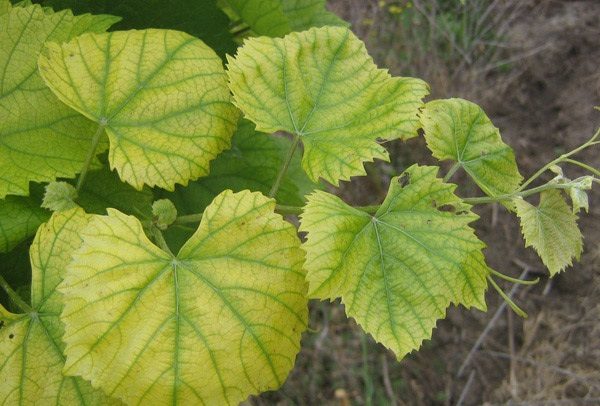
Rubella leaves
In late spring or early summer, vines can become infected with this fungal disease. It affects the grape leaves, damaged by insects.
To determine the infection of the bush with rubella can be on the following grounds:
- the sheets in the lesions have spots like a maple leaf, covered with rusty patina;
- before the beginning of the flowering period, infected leaves fall off;
- white grapes leaves are covered with light yellow spots, gradually darkening, outlined by a yellow border;
- dark varieties have bright red spots.
To avoid infection you need:
- process leaves Bordeaux mixture;
- carry out regular pruning bushes;
- rake and burn fallen leaves;
- to apply top dressing to the soil;
- dig up the aisles.
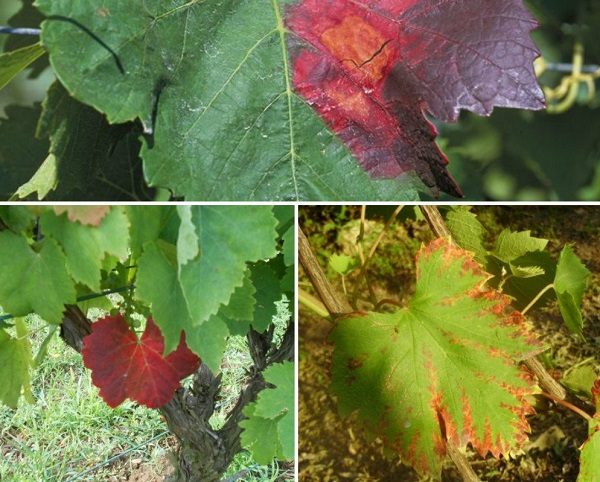
Septoria
It is characteristic for muscat grapes.Manifested in the form of small brown spots on the sheets. If the humidity is high, then mold forms on the underside of the leaves. When dried, it falls and spreads the spores of the fungus.
As a preventive measure, it is necessary to treat with a 1% solution of the Bordeaux mixture.

Disease escoriosis
Escoriosis is a dangerous fungal disease affecting all parts of the plant. It is a black spot on the leaves and shoots of the bush. The most rapid spread in cool weather with high humidity. Affected bushes become weak, while their frost resistance decreases.
If the bushes are severely damaged after autumn pruning, dried sleeves are removed and the bushes are carefully treated with copper-containing preparations.
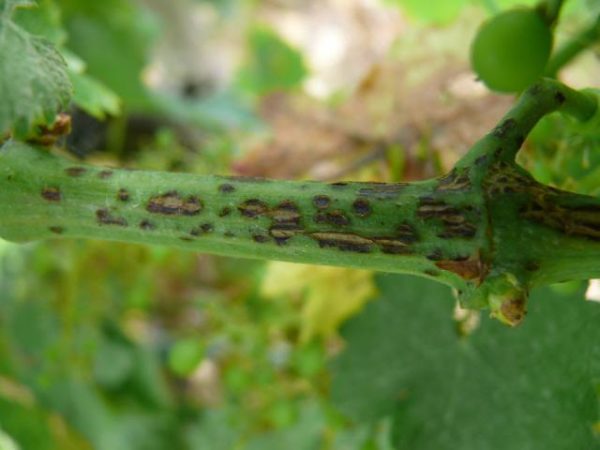
Preventive measures:
- compulsory fertilization containing zinc and boron;
- timely formation of the bush;
- removal and burning of affected parts;
- use of healthy seedlings for planting.
To protect the vineyard from diseases, it is necessary to observe the conditions of growing grapes and timely conduct preventive measures to prevent the spread of infections. It is recommended to plant those varieties that are most suitable for cultivation in the region.
